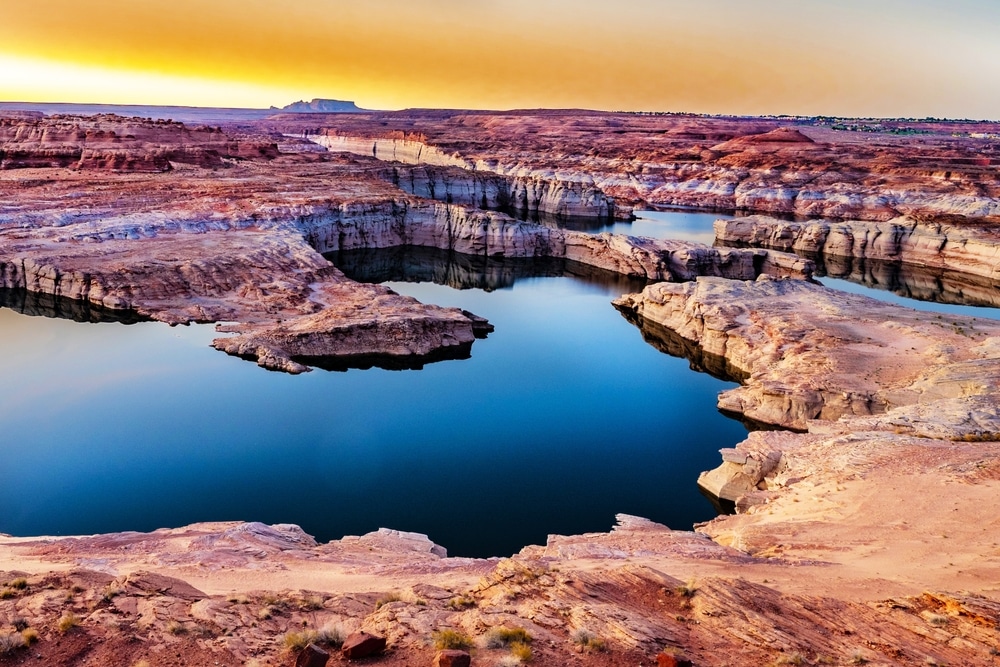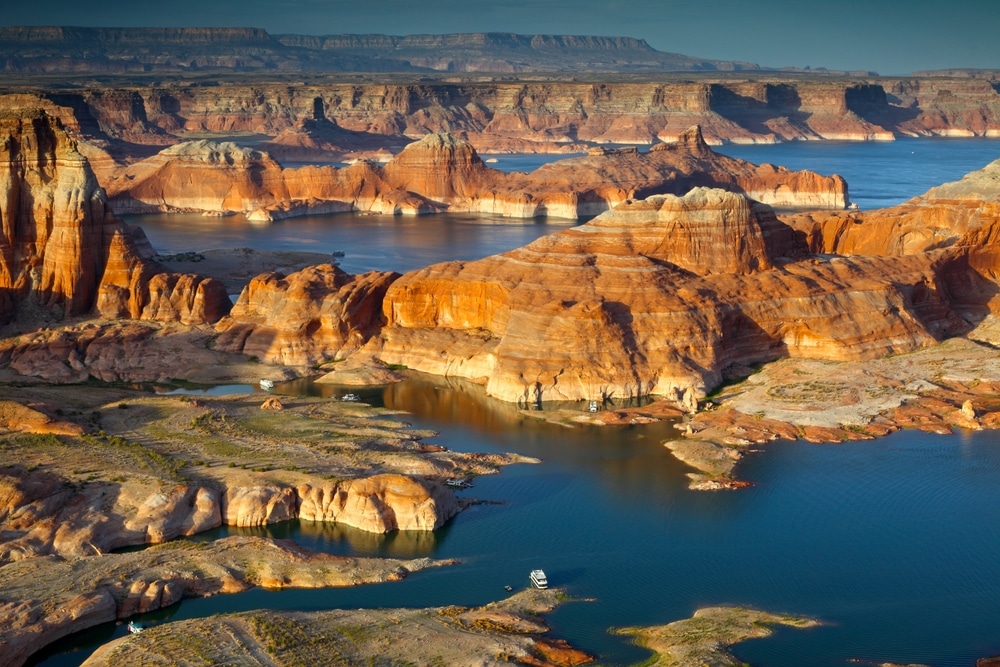- Privacy
- Terms
- Stay Connected
Against the striking red sandstone backdrop of northern Arizona lies Lake Powell, a mesmerizing expanse of turquoise water that winds through ancient canyons like a liquid sapphire. This remarkable reservoir stretches across the Arizona-Utah border, creating one of America’s most spectacular water playgrounds. Located in the Glen Canyon National Recreation Area, Lake Powell is one of the most visited lakes in the United States, offering a scenic natural backdrop that rivals neighboring Grand Canyon, Monument Valley, and Painted Desert in its astonishing beauty.
Lake Powell is situated primarily in southern Utah with a smaller portion extending into northern Arizona’s Coconino County. The lake was created by the flooding of Glen Canyon by the Glen Canyon Dam, which led to the 1972 establishment of Glen Canyon National Recreation Area. Visitors can access Lake Powell primarily through the city of Page, Arizona, located at coordinates 36.9147° N, 111.4558° W, approximately 130 miles north of Flagstaff via US Highway 89. The nearest major airport is in Phoenix, about 280 miles south, with Flagstaff Pulliam Airport serving as a closer regional option.

The lake is named after Major John Wesley Powell, a one-armed Civil War veteran who led pioneering expeditions down the Colorado River in 1869 and 1872, charting what was then the last blank spot on the map of the United States. Unlike natural lakes formed by glacial activity or tectonic shifts, Lake Powell is entirely man-made, serving as a critical component of the Colorado River Storage Project and playing a vital role in the water management system of the American Southwest.


Lake Powell’s most distinctive feature is its maze of narrow sandstone canyons accessible primarily by boat. Forbidding Canyon leads to the famous Rainbow Bridge National Monument, while Cathedral Canyon, Labyrinth Canyon, and Cascade Canyon offer otherworldly scenery with soaring walls, natural arches, and hanging gardens. These slot canyons provide cooler temperatures and spectacular photo opportunities with their dramatic light and shadow interplay.

Lake Powell features countless sandy beaches and swimming areas that emerge as water levels fluctuate. Warm Creek Bay and Lone Rock Beach offer extensive sandy shorelines perfect for swimming and sunbathing. The lake’s warm water temperatures in summer (often reaching 80°F) make it ideal for extended water play, with many hidden beaches accessible only by boat providing private swimming experiences.

Lake Powell offers an unparalleled boating experience with nearly 2,000 miles of shoreline and countless side canyons to explore. The vast reservoir accommodates everything from small kayaks to luxury houseboats. The main channel provides open waters for water skiing and wakeboarding, while the narrow slot canyons create intimate waterways perfect for peaceful exploration. Marinas at Wahweap, Bullfrog, Halls Crossing, and Antelope Point provide comprehensive services including boat rentals and supplies.

The lake hosts thriving populations of smallmouth bass, largemouth bass, striped bass, crappie, and walleye. The numerous coves and underwater structures create ideal fishing habitats. Spring and fall typically offer the best fishing conditions, though different species peak at different times. Popular fishing areas include Warm Creek Bay, Padre Bay, and the San Juan Arm, with fishing guides available for those seeking local expertise.

While most of Lake Powell’s attractions are water-accessible, several hiking trails offer spectacular views of the lake and surrounding landscape. The Hole-in-the-Rock Trail follows historic pioneer routes, while shorter trails from marinas lead to panoramic viewpoints. For more adventurous hikers, the backcountry areas surrounding the lake offer challenging routes through slot canyons and along mesa tops.

Rainbow Bridge National Monument, one of the world’s largest natural bridges, is Lake Powell’s most famous attraction. Accessible via a scenic boat ride followed by a short hike, this sacred Native American site spans 290 feet across Bridge Canyon. The massive sandstone arch rises 290 feet above the canyon floor, creating one of the most photographed natural wonders in the Southwest.

Lake Powell’s dramatic landscape creates endless photography opportunities. The contrast between deep blue waters and red sandstone walls is particularly striking at sunrise and sunset. Cathedral in the Desert, Face Canyon, and Reflection Canyon offer some of the most photogenic locations, while the ever-changing light conditions throughout the day transform familiar scenes into new compositions.

Lake Powell offers diverse camping experiences from developed campgrounds to remote beach camping. Wahweap and Bullfrog marinas provide campgrounds with full amenities, while Lone Rock Beach allows drive-up primitive camping directly on the shoreline. For a truly unique experience, houseboats can be anchored along countless beaches throughout the lake, allowing visitors to sleep under the stars with the canyon walls as their backdrop.
Lake Powell offers exceptional fishing opportunities throughout the year, making it one of Arizona’s premier angling destinations. The lake is home to a variety of game fish species including striped bass, smallmouth bass, largemouth bass, walleye, crappie, channel catfish, and bluegill. Each species provides unique challenges and rewards for anglers of all skill levels.
Fishing success at Lake Powell has been on an upswing during recent years, with fish reported as big, healthy, and fun to catch. Many bass tournaments are held at the lake, attracting professional anglers, though the lake is equally welcoming to novice fishermen. With more than 160,000 acres of fishable water and many miles of shoreline, boat access provides the best opportunity to reach trophy fishing spots.
The prime fishing areas vary by season and species. Striped bass are typically found in deeper waters toward the backs of canyons, especially during spring when they stage to spawn in late April and May. Smallmouth bass prefer areas with gravel or smooth rock points, particularly as the water warms in late spring. Largemouth bass are commonly found in the backs of canyons following the shad in fall. Walleye fishing is typically best in May and June.
For equipment and supplies, the Wahweap Marina Store and Bullfrog Boat & Go Store stock fishing tackle, equipment, and bait. Recommended baits include anchovies and night crawlers, which work well for many of the lake’s fish species. A valid fishing license is required for all anglers. Utah fishing licenses are valid throughout Lake Powell, including the Arizona portion, making license management simpler for visitors.
Seasonal patterns significantly impact fishing success at Lake Powell. Spring (April-May) and fall (September-October) generally offer the best fishing conditions when water temperatures are moderate and fish are most active. During summer heat, fish tend to move deeper, requiring different techniques, while winter fishing slows but can still be productive for dedicated anglers.
Most marinas provide fish cleaning stations, allowing anglers to properly prepare their catch before returning to camp or heading home. For those unfamiliar with the lake, guided fishing trips are available, offering valuable local knowledge and increasing your chances of landing a memorable catch.
Boating is by far the most popular activity in Glen Canyon National Recreation Area, with over two million visitors enjoying the deep turquoise waters of Lake Powell every year. The vast expanse of the lake provides ample space for all types of watercraft and water activities, from serene paddling excursions to high-speed water sports.
Lake Powell permits a wide variety of watercraft including motorboats, jet skis, houseboats, sailboats, kayaks, and paddleboards. There are no horsepower restrictions on most parts of the lake, though some narrow canyon areas maintain no-wake zones to protect the shoreline and enhance safety. All watercraft must comply with National Park Service regulations regarding safety equipment, lighting, and registration.
The lake features several well-maintained boat launch facilities across its length. The most active center for boat excursions is Wahweap Marina near Page, Arizona, though several other marinas and launch points exist throughout the lake. Bullfrog Marina serves as the primary northern access point for Utah visitors. Boat ramps at Antelope Point, Halls Crossing, and Hite (when water levels permit) provide additional access points.
Navigation on Lake Powell presents unique challenges due to its canyon geography. Hazards include submerged rock formations, fluctuating water levels that can expose new obstacles, and narrow passages that require careful maneuvering. Detailed lake maps are available at marinas and visitor centers to help boaters navigate safely. The lake uses a buoy system to mark main channels and hazardous areas.
Boat rentals are available at multiple marinas around the lake, including powerboats, pontoons, jet skis, and houseboats of various sizes. Wahweap Marina and Bullfrog Marina offer the most extensive rental fleets and services. Fuel stations are located at all major marinas, with Dangling Rope Marina serving as a mid-lake refueling point accessible only by water.
Houseboating deserves special mention as a signature Lake Powell experience. These floating vacation homes range from basic models to luxury vessels with multiple bedrooms, full kitchens, waterslides, and hot tubs. Houseboats allow visitors to explore remote parts of the lake at a leisurely pace while enjoying all the comforts of home, creating an unparalleled vacation experience.
Lake Powell’s crystal-clear waters and countless secluded coves make it an ideal destination for swimming and water sports enthusiasts. With summer water temperatures reaching the high 70s to low 80s°F, the lake provides refreshing relief from the desert heat while offering endless recreational possibilities.
Designated swimming beaches can be found at major marina areas, including Wahweap, Bullfrog, and Antelope Point. These beaches typically feature gentle slopes into the water, making them family-friendly options with nearby amenities such as restrooms, picnic areas, and parking. However, one of Lake Powell’s unique attractions is the ability to find your own private beach among the many coves and inlets that line the shoreline.
Water quality for swimming is generally excellent throughout most of the lake, with visibility often extending 15-20 feet below the surface. The Bureau of Reclamation and National Park Service monitor water quality regularly, with any health advisories posted at marinas and visitor centers. Algae blooms occasionally occur during hot late-summer periods, particularly in shallow areas with limited water circulation.
Water sports thrive on Lake Powell’s expansive blue waters. On a typical summer day, many boaters take advantage of the lake’s size and calm water to enjoy water-skiing, wakeboarding, tubing, and just relaxing on the water. The main channel provides ample room for high-speed activities, while side canyons offer smoother water for beginners or those seeking a more controlled environment.
Lake Powell is also recognized as one of the world’s top stand-up paddleboarding (SUP) destinations. Paddleboarding and kayaking allow visitors to explore narrow side canyons inaccessible to larger boats, providing intimate encounters with the stunning geology and wildlife. Rental equipment is available at most marinas for those who don’t bring their own.
Safety considerations are particularly important for water activities at Lake Powell. The lake’s remote nature means emergency services may be distant, so personal responsibility is essential. Life jackets are required for children under 12 on boats and recommended for all swimmers in open water. The combination of deep water and high cliffs also attracts cliff jumpers, though this activity is dangerous and discouraged by park authorities due to submerged hazards and varying water depths.

| Category | Details |
|---|---|
| Location | Border between Utah and Arizona, USA |
| Formation | Created by Glen Canyon Dam, completed in 1963 |
| Surface Area | Approximately 161,390 acres (653 km²) at full capacity |
| Length | About 186 miles (299 km) |
| Shoreline | Approximately 1,960 miles (3,150 km) |
| Maximum Depth | Around 560 feet (170 m) near the dam |
| Maximum Capacity | 24.3 million acre-feet (30 km³) |
| Dam Type | Concrete arch |
| Dam Height | 710 feet (216 m) |
| Dam Length | 1,560 feet (475 m) |
| Water Source | Colorado River |
| Purpose | Water storage, flood control, hydroelectric power, recreation |
| Hydroelectric Capacity | 1,320 megawatts at Glen Canyon Dam |
| Named After | John Wesley Powell, one-armed Civil War veteran and explorer |
| Management | Glen Canyon National Recreation Area (National Park Service) |
| Recreation | Boating, fishing, water sports, houseboating, swimming, kayaking |
| Notable Features | Red rock canyon walls, natural bridges, Rainbow Bridge National Monument |
| Recent Challenges | Significant drought conditions causing historic low water levels |
| Visitation | Approximately 2 million visitors annually |
| Wildlife | Home to numerous fish species, desert bighorn sheep, and various bird species |
| Environmental Impact | Controversial for flooding Glen Canyon’s natural features and ecosystems |
Lake Powell is a magnificent engineering marvel and natural wonder with impressive dimensions that make it one of North America’s largest man-made bodies of water. The lake stretches nearly 300 kilometers from end to end with a surface area of 254 square miles and a total volume of 7.198 cubic miles. With over 2,000 miles of shoreline—more than the combined coastlines of the Pacific states—Lake Powell offers more shoreline than the entire west coast of the continental United States.
Lake Powell reaches a maximum depth of 583 feet (178 meters), though its average depth is around 132 feet (40 meters). The lake sits at an elevation of approximately 3,700 feet above sea level when at full capacity, though water levels have fluctuated significantly in recent decades due to drought conditions affecting the Colorado River Basin.
The Colorado River serves as the primary water source for Lake Powell, contributing around 85% of the inflow, with additional contributions from the San Juan, Escalante, and Dirty Devil Rivers. The slower flow of the San Juan River has produced fascinating goosenecks where 5 miles of river are contained within 1 mile on a straight line. Water clarity in Lake Powell is generally excellent, with visibility often extending 15-20 feet below the surface, especially in areas away from boat traffic and river inflows.
The lake is framed by towering sandstone cliffs that rise hundreds of feet from the water’s surface, creating dramatic vistas and countless secluded coves. The geology of the area features layers of sandstone, conglomerate, and shale from the Straight Cliffs Formation that underlies the Kaiparowits Plateau and San Rafael Swell to the north of the lake. The contrast between the deep blue water and the red-orange sandstone creates a visual spectacle that draws photographers and nature lovers from around the world.
The lake experiences typical desert temperature swings, with surface water temperatures ranging from the 40s°F in winter to the high 70s-low 80s°F during summer months. This temperature variation, combined with the lake’s size and unique canyon geography, creates microclimates that support a diverse ecosystem within an otherwise arid environment.
Glen Canyon Dam is the second highest concrete-arch dam in the United States, second only to Hoover Dam which stands at 726 feet. Standing 710 feet (216 m) high, Glen Canyon Dam was built by the Bureau of Reclamation (USBR) from 1956 to 1966, creating Lake Powell with a capacity of more than 25 million acre-feet (31 km³). This engineering marvel forms the backbone of Lake Powell and serves multiple crucial purposes for the southwestern United States.
The dam is classified as a concrete arch-gravity dam, a design chosen specifically to withstand the immense pressure of the Colorado River while fitting perfectly within the narrow sandstone walls of Glen Canyon. Construction began on October 15, 1956, when President Dwight D. Eisenhower pressed a telegraph key from Washington D.C. to set off the first dynamite blast, signaling the beginning of construction. Over 5 million cubic yards of concrete were used in its construction at a cost of $155 million (equivalent to over $1.4 billion today).
The Glen Canyon Dam is managed by the Bureau of Reclamation, with its primary purpose being to provide long-term water storage that allows the Upper Basin states (Wyoming, Colorado, New Mexico, and Utah) to utilize their share of the Colorado River while still delivering the required water to the Lower Basin states (Arizona, California, and Nevada). This massive “bank account” of water helps the region weather extended dry periods by sustaining the needs of cities, industries, and agriculture throughout the West.
The dam’s power plant, equipped with eight generators with a total capacity of 1,320 megawatts, produces around five billion kilowatt-hours of hydroelectric power annually which is distributed by the Western Area Power Administration to Wyoming, Utah, Colorado, New Mexico, Arizona, Nevada, and Nebraska. This power generation capability makes Glen Canyon Dam a significant source of renewable energy for the southwestern power grid.
After the dam wall was completed in 1963, work began on the power plant and spillways. To save costs, the spillway tunnels were excavated around both abutments of the dam, dropping steeply from their control gates on Lake Powell to merge with the lower ends of the diversion tunnels. The first electricity was generated on September 4, 1964, with the remaining work completed over the next two years.
On September 22, 1966, the nation’s First Lady, Claudia “Lady Bird” Johnson, dedicated Glen Canyon Dam and Powerplant before a crowd of 3,000 people. Today, visitors can tour the dam to learn about its construction and history, as well as its continuing role in water management and power generation for the Southwest.
Environmental adaptations have been implemented over the years to mitigate the dam’s impact on downstream ecosystems. The Glen Canyon Adaptive Management Program conducts controlled high-flow releases to restore sandy beaches in the Grand Canyon and improve habitat for aquatic species. While controversial among environmental groups who advocate for the restoration of Glen Canyon to its natural state, the dam continues to fulfill its vital role in water security and power generation for the region.
Lake Powell offers diverse overnight accommodations ranging from primitive shoreline camping to upscale resort experiences, ensuring options for every preference and budget. The variety of settings allows visitors to craft their ideal lake experience, whether seeking solitude under starlit skies or comfortable amenities after a day on the water.
Developed campgrounds around Lake Powell provide organized spaces with essential amenities. Wahweap Campground near Page, Arizona features 139 sites with stunning lake views, accommodating tents and RVs up to 45 feet. Amenities include restrooms with flush toilets and hot showers, picnic tables, fire rings, drinking water, and dump stations. Most sites have electricity hookups, with prices ranging from $30-50 per night depending on amenities and season. The campground offers both advance reservations and first-come, first-served options.
Shoreline camping is a signature Lake Powell experience, allowing visitors to camp anywhere on the lake’s 2,000 miles of shoreline except in developed marinas. No camping fee or permit is required for shoreline camping, though entrance fees and vessel use fees apply. This option provides unparalleled flexibility to find secluded beaches and coves accessible only by boat. These primitive sites have no amenities, requiring campers to pack in everything they need and pack out all waste following Leave No Trace principles.
Bullfrog Campground, on the Utah side of the lake, offers 78 sites accommodating both tents and RVs with similar amenities to Wahweap. Nearby Stanton Creek and Hite campgrounds provide more primitive options with vault toilets and limited services, appealing to those seeking a more rustic experience. These northern campgrounds typically see less visitation than Wahweap, offering better availability during peak season.
For those preferring indoor accommodations, lodging options include the Lake Powell Resort at Wahweap Marina, offering comfortable rooms with lake views, restaurants, a swimming pool, and other amenities. Defiance House Lodge at Bullfrog Marina provides similar comforts in the northern lake area. Room rates typically range from $150-300 per night depending on season and view.
The city of Page, Arizona serves as the gateway community to Lake Powell, offering additional accommodation options including numerous hotels, motels, vacation rentals, and bed-and-breakfasts within a 15-minute drive of Wahweap Marina. These range from budget-friendly options starting around $80/night to upscale properties exceeding $300/night during peak summer season.
All campgrounds and lodges at Lake Powell operate on a seasonal basis, with peak season running April through October. Reservations are strongly recommended, especially for summer weekends and holidays when facilities often book months in advance. The National Park Service’s reservation system (recreation.gov) handles campground bookings, while lodging reservations are managed through Aramark, the park concessionaire.
Pet policies vary by accommodation type. Most campgrounds allow pets with standard leash requirements, while the Lake Powell Resort permits pets in designated rooms for an additional fee. Quiet hours are generally enforced from 10 PM to 6 AM throughout all overnight facilities.
Glen Canyon National Recreation Area encompasses 1.2 million acres of the Colorado Plateau, hosting an intricate ecosystem with diverse wildlife and plant species adapted to the arid environment. Despite the harsh desert conditions, Lake Powell and its surrounding landscape support a surprising variety of life, creating a fascinating natural setting for visitors to explore.
The introduction of Lake Powell dramatically transformed the native ecosystem, creating a unique blend of desert and aquatic environments. The transition zones between water and land provide particularly rich habitat diversity, supporting species that would otherwise be unable to survive in the arid region. These riparian areas are especially important for migrating birds and other wildlife.
Bird enthusiasts will be delighted to learn that over 315 species of birds have been documented within Glen Canyon National Recreation Area, including owls, herons, eagles, and various waterfowl. Bald eagles and peregrine falcons represent notable raptor species that have made a remarkable recovery in the region. The lake attracts numerous migratory birds, with spring and fall offering the best viewing opportunities as species travel along the Pacific Flyway.
Mammals native to the area include desert bighorn sheep, which can occasionally be spotted navigating the steep canyon walls with remarkable agility. Other mammals include mule deer, coyotes, and bobcats, though these tend to stay away from humans and are most active during early morning and evening hours. Desert cottontails, jackrabbits, and various rodent species form the foundation of the mammalian food web.
Reptiles abound in Glen Canyon National Recreation Area, from various lizard species to snakes that have adapted to the harsh desert conditions. The western diamondback rattlesnake and gopher snake are common serpent species, while side-blotched lizards and desert spiny lizards frequently bask on sun-warmed rocks. Near the water’s edge, visitors might encounter amphibians like the red-spotted toad, particularly active during evening hours.
The aquatic ecosystem within Lake Powell has evolved significantly since the dam’s construction, with introduced game fish now thriving in its clear waters. These include bass, crappie, walleye, bluegill, and catfish. The lake’s fish population supports both recreational fishing and a food source for birds of prey like osprey and bald eagles.
The plant communities surrounding Lake Powell exemplify remarkable adaptations to survive in an environment with limited rainfall and extreme temperature fluctuations. Drought-resistant species dominate the landscape, including various cacti, yucca, and desert shrubs that have evolved water-storage capabilities and reduced leaf surfaces to minimize evaporation. Along the shoreline, tamarisk (salt cedar)—though considered invasive—provides important habitat for numerous bird species.
Conservation challenges in the Lake Powell ecosystem include the spread of invasive species like quagga mussels, which threaten native aquatic organisms and infrastructure. These mussels have infested several important waters in Arizona including Lake Powell, and have few natural predators while feeding on aquatic plants, insects and other invertebrates. Drought and climate change present additional stressors to both terrestrial and aquatic systems.
Visitors can enhance wildlife viewing opportunities by exploring during early morning or evening hours when animals are most active, maintaining a respectful distance, using binoculars or telephoto lenses, and moving quietly through natural areas. The Glen Canyon Visitor Center offers interpretive displays on the region’s ecology and can provide guidance on seasonal wildlife viewing opportunities.
Lake Powell experiences distinct seasonal variations that significantly impact visitor experiences, activities, and overall enjoyment of this remarkable destination. Understanding these seasonal patterns is crucial for planning a successful visit tailored to your preferred activities and comfort level.
Spring (March-May) brings mild temperatures ranging from 50-80°F, making it ideal for hiking, photography, and early-season boating. The landscape awakens with desert wildflowers creating splashes of color against the red sandstone backdrop, particularly in April after winter precipitation. Spring typically sees increasing water levels as snowmelt from the Rocky Mountains begins feeding the Colorado River system. Fishing excels during this period as bass begin their spawning activities in shallow waters, particularly in April and May. Visitor numbers remain moderate except during spring break weeks, offering a good balance of amenable weather and lower crowds.
Summer (June-August) represents the peak season at Lake Powell, with daytime temperatures consistently reaching 90-105°F. These hot conditions make water activities particularly refreshing, with water temperatures warming to the high 70s-low 80s°F. Summer brings the highest visitor numbers, especially on weekends and holidays when marinas and popular beaches can become crowded. Boating, swimming, and water sports dominate summer activities, with many visitors opting for multi-day houseboat rentals to escape the crowds. Afternoon thunderstorms occasionally develop, creating brief but potentially dangerous conditions on the water. Advance reservations for all accommodations become essential during this busy period.
Fall (September-October) offers perhaps the most pleasant visitor experience, combining warm water temperatures with moderating air temperatures of 65-85°F. The lake typically reaches its lowest annual levels during this period after summer withdrawals. Fish sense winter coming and feed voraciously, making fall an excellent time for fishing enthusiasts. Visitor numbers decrease significantly after Labor Day, creating opportunities for more solitary exploration of the lake’s many coves and side canyons. Fall colors are subtle but beautiful in riparian areas, enhanced by the golden evening light for photography.
Winter (November-February) transforms Lake Powell into a tranquil retreat with daytime temperatures ranging from 40-60°F and overnight lows sometimes dropping below freezing. Many facilities operate on reduced hours or close entirely, including some marinas and visitor services. Water levels generally begin to stabilize or rise slightly as downstream demand decreases. Winter fishing continues for dedicated anglers, with fish moving deeper and requiring more technical approaches. The dramatic reduction in visitation creates opportunities for solitude and wildlife viewing, though boaters must prepare for cold conditions and limited services. Accommodation prices reach their lowest points during this off-season.
Water level fluctuations remain a critical consideration for Lake Powell visitors regardless of season. Drought conditions in recent years have led to significant drops in lake levels, affecting access points, revealing new shoreline features, and occasionally rendering boat ramps unusable. Before visiting, checking current lake levels through the National Park Service or Bureau of Reclamation websites is highly recommended, especially for boaters planning to use specific launch facilities.
As of recent updates, the entrance fee for Lake Powell/Glen Canyon National Recreation Area is $30 per vehicle, valid for seven days. Annual passes are available for $55, granting unlimited entry for 12 months. Additionally, the America the Beautiful National Parks and Federal Recreational Lands Pass ($80) covers entrance fees at all National Park Service sites nationwide for one year, offering excellent value for frequent visitors.
Boaters must pay vessel fees in addition to entrance fees. These range from $20-30 for motorized vessels depending on size, while non-motorized craft like kayaks incur lower fees of approximately $16. Annual vessel passes are available for frequent visitors. Camping fees vary by location, with developed campgrounds typically charging $30-50 per night depending on amenities and season.
Glen Canyon National Recreation Area operates year-round, though services vary seasonally. The lake itself is accessible 24 hours daily, while visitor centers and ranger stations generally operate from 8:00 AM to 5:00 PM, with extended summer hours. Some facilities, particularly in northern areas like Bullfrog Marina, reduce operations during winter months.
The main Glen Canyon Visitor Center is located near the dam in Page, Arizona, offering interpretive displays, maps, permits, educational programs, and ranger assistance. Additional information stations operate seasonally at Bullfrog and Halls Crossing marinas. Park rangers conduct interpretive programs during summer months, including geology talks, star-gazing events, and guided hikes.
Emergency medical services are available in Page, Arizona, with Bullfrog Marina offering limited emergency care during peak season. For emergencies on the lake, visitors should use Marine Band Channel 16 or call 911 if cell service is available. Response times may be extended due to the lake’s size and remote nature, underscoring the importance of personal safety preparedness.
National Park Service rangers patrol the lake, providing assistance and enforcing regulations. Their presence increases during summer months when visitor numbers peak. Glen Canyon’s remote nature means cell phone coverage is inconsistent across the lake, with reliable service primarily near Page and major marinas. Emergency phones are located at developed marinas.
Major facilities at Wahweap and Bullfrog marinas offer accessible pathways, restrooms, and viewing areas compliant with ADA standards. Some houseboats in the rental fleet feature wheelchair accessibility, though advance reservation is essential. The Lake Powell Resort includes accessible rooms and public areas. While the natural landscape presents inherent challenges, efforts continue to improve accessibility throughout the recreation area.
Potable water is available at all developed marinas and campgrounds but not along undeveloped shorelines. Visitors camping away from facilities must bring adequate water supplies, calculating at least one gallon per person per day in this arid environment.
All developed areas provide trash and recycling facilities. Shoreline campers must pack out all waste, following Leave No Trace principles. Houseboat renters receive detailed instructions on gray water and waste management, with pump-out services available at major marinas. Visitors should note that discharging any waste into the lake is strictly prohibited and carries significant penalties.
Fire regulations vary seasonally based on conditions, with temporary bans common during dry summer months. Within developed campgrounds, fires must be contained within designated fire rings. Shoreline campers may have fires below the high-water mark in areas with minimal vegetation, though collecting driftwood is prohibited. Portable fire pans are recommended for backcountry use. All visitors should check current fire restrictions at visitor centers or ranger stations upon arrival.
Pets are permitted in developed areas if leashed (maximum 6-foot leash) and never left unattended. They are allowed on vessels and some beaches but prohibited in certain sensitive habitat areas. Owners must clean up after pets and ensure they don’t disturb wildlife or other visitors. Service animals are allowed in all public areas in accordance with ADA regulations.
While Lake Powell itself offers endless exploration opportunities, the surrounding region contains numerous world-class attractions that complement any visit to this remarkable reservoir. Within an hour’s drive from the lake’s southern shores, visitors can experience some of the American Southwest’s most spectacular natural wonders.
The city of Page, Arizona serves as the gateway to Lake Powell and hosts several notable attractions. At Horseshoe Bend, visitors can take a relatively short hike (just over 1 mile roundtrip) to a scenic overlook that provides breathtaking views of the Colorado River as it winds through Glen Canyon. This iconic viewpoint, located just off Highway 89, has become one of the most photographed locations in the Southwest and is particularly stunning during golden hour lighting.
Antelope Canyon, located on the south shore of Lake Powell near Page, attracts hikers to its astonishing slot canyons. Divided into Upper and Lower sections, these narrow, twisting sandstone passages create otherworldly light beams and color displays that draw photographers from around the world. As the canyons are located on Navajo Nation land, visitors must join authorized guided tours, which can be arranged through various operators in Page.
Rainbow Bridge National Monument represents another must-see attraction accessible from Lake Powell. At 278 feet wide and standing 290 feet above the streambed, Rainbow Bridge remains one of the world’s largest natural stone bridges and a favorite Lake Powell destination. While historically requiring a long hike, the formation is now most commonly visited by boat tours from Wahweap Marina or private vessels navigating to the Rainbow Bridge boat dock, followed by a moderate hike to the viewing area.
Lees Ferry, located 42 miles from Page at the southern end of Glen Canyon, offers both historical significance and recreational opportunities. This area features remnants of early settlement attempts, including stone buildings, a steam boiler, and the remains of a sunken paddlewheel steamboat from Charles H. Spencer’s gold mining operation in 1910. Today, Lees Ferry serves as the launching point for Grand Canyon rafting expeditions and offers excellent fishing in the clear, cold waters below Glen Canyon Dam.
The vast Navajo Nation surrounds much of Lake Powell, offering glimpses into Native American culture and history. The Navajo Nation covers more than 27,000 square miles of desert landscape around the Four Corners region, with many treasures to explore. Cultural centers, trading posts, and guided tours provide opportunities to learn about Navajo traditions, art, and contemporary life.
For those willing to venture a bit farther, Grand Canyon National Park’s North Rim lies approximately 125 miles southwest of Page. Less visited than the South Rim, this section of the canyon offers stunning viewpoints and hiking trails without the crowds found at other sections of the national park. The elevated North Rim (8,000+ feet) provides a cooler alternative during hot summer months.
Monument Valley Navajo Tribal Park, located about 125 miles east of Lake Powell, features iconic sandstone buttes and mesas that have defined the American West in countless films and photographs. Guided Navajo tours offer insights into both the cultural and geological significance of this unforgettable landscape.
Local dining options center primarily around Page, Arizona, where restaurants range from casual southwestern fare to fine dining establishments. Chain restaurants and local eateries offer variety, while grocery stores like Walmart Supercenter and Safeway provide supplies for self-catering visitors. The Lake Powell Resort features The Rainbow Room restaurant with panoramic lake views and Driftwood Lounge for more casual dining.
When preparing for your Lake Powell adventure, prioritize sun protection, including broad-spectrum sunscreen (SPF 50+), wide-brimmed hats, sunglasses with UV protection, and UPF-rated clothing. The desert sun reflects off both water and sandstone, intensifying exposure. Bring more water than you think necessary—at least one gallon per person per day for shoreline camping—and reusable water bottles for day trips.
Footwear deserves special consideration: pack closed-toe water shoes for navigating the sometimes sharp shorelines and unknown underwater terrain, plus sturdy hiking boots for exploring the surrounding desert. Temperature swings can be dramatic, so include layers even in summer, with lightweight long sleeves for sun protection and warmer options for evenings. A dry bag or waterproof case for electronics, phones, and valuables is invaluable in this water-centric environment.
The combination of high desert elevation, intense sun, and dry air makes dehydration a primary concern at Lake Powell. Drink water consistently throughout the day, even if not feeling thirsty, and monitor for headaches, dizziness, or unusual fatigue. Heat-related illnesses pose serious risks during summer months; schedule strenuous activities for morning or evening hours and seek shade during peak afternoon heat.
Lake safety requires vigilance: wear properly fitted life jackets when on the water, especially for children and weaker swimmers. Be aware that water depths can change dramatically with little warning, particularly in narrow canyons. Check weather forecasts before boating, as afternoon thunderstorms can develop quickly, creating dangerous conditions with high winds and waves.
Flash floods represent a significant hazard, particularly in slot canyons and dry washes. Never enter these areas if rain threatens, even if precipitation is falling miles away. Wildlife encounters generally pose minimal risks if animals are given space and not fed; however, rattlesnake awareness is important when hiking, requiring closed-toe shoes and careful placement of hands and feet on rocks or ledges.
First-time boaters should purchase detailed lake maps showing the numerous side canyons, underwater hazards, and navigation markers. GPS systems specifically designed for marine use are highly recommended as cellular navigation apps often lose signal in remote canyon areas. Learn to use the buoy system—red markers indicate the right side of main channels when traveling upstream, while green markers denote the left side.
Landmarks look remarkably similar across the lake, making it easy to become disoriented, especially in side canyons. Note distinctive rock formations, take photos of your route, and always inform someone of your intended destination and return time. Remember that the lake’s water level can vary significantly between visits, revealing new features and hazards as the level changes.
To experience Lake Powell’s tranquility, avoid summer holidays and weekends when popular beaches and marinas reach capacity. Mid-week visits, even during summer, offer significantly reduced crowds. Consider exploring the lake’s northern sections near Bullfrog Marina, which typically sees fewer visitors than the Wahweap area. Early mornings provide magical lighting for photography and peaceful conditions before day-trippers arrive.
The lake’s vast shoreline means solitude is always available for those willing to venture beyond the main channels. Side canyons like Labyrinth, Iceberg, and Last Chance provide stunning experiences with minimal traffic. Travel just 30-45 minutes by boat from major marinas to find secluded coves perfect for overnight camping or day-use relaxation.
Lake Powell presents unique photographic opportunities but also distinct challenges. The extreme contrast between bright sandstone and dark shadows requires graduated filters or HDR techniques. Early morning and late afternoon offer the most dramatic lighting as the low sun angle brings out the texture and color of the sandstone walls.
For landscape photography, wide-angle lenses (16-35mm) capture the expansive canyon vistas, while telephoto lenses isolate interesting rock formations and compress the layers of sandstone. Boat-based photography requires high shutter speeds (at least 1/500 sec) to combat motion and vibration. Protect your equipment from water, sand, and dust with appropriate covers or weatherproof housing.
Beyond weather and standard boating safety, Lake Powell presents unique hazards visitors should understand. Fluctuating water levels can expose or submerge rock formations between visits, requiring constant vigilance even in previously navigated channels. Canyon walls occasionally shed rock debris, particularly after freeze-thaw cycles in winter and spring, making it advisable to avoid anchoring directly beneath steep cliffs.
The remote nature of many lake sections means emergency response times can be extended. Carry basic first aid supplies, signaling devices, and extra provisions. During summer, the sandy shorelines can reach extreme temperatures capable of causing burns to bare feet—appropriate footwear is essential when exploring beaches.
Lake Powell’s fragile desert ecosystem requires conscious visitor stewardship. Pack out all trash, including food scraps that can attract unwanted wildlife. Use established bathroom facilities at marinas or portable systems on houseboats, following proper disposal protocols to protect water quality.
Minimize noise pollution, particularly in narrow canyons where sound amplifies dramatically. Respect the 5 mph no-wake zones near marinas and narrow passages. When encountering wildlife, maintain distance and avoid disrupting natural behaviors. Preserve cultural resources by viewing petroglyphs and historical sites without touching or disturbing them. Remember that removing artifacts or damaging geological features is prohibited and carries significant penalties.
Lake Powell stands as a magnificent testament to both natural splendor and human engineering, creating a destination unlike any other in America. This extraordinary reservoir offers a perfect synthesis of adventure and tranquility, where visitors can spend mornings exploring hidden canyons and afternoons relaxing on secluded beaches beneath towering red cliffs.
The lake’s immense scale and extraordinary setting provide nearly endless opportunities for discovery, ensuring that even repeat visitors continue to find new coves, viewpoints, and experiences. Whether you’re piloting a houseboat through winding waterways, casting a line for striped bass, or simply watching the play of light and shadow across ancient sandstone walls, Lake Powell offers moments of awe and connection with the natural world.
As stewards of this remarkable environment, every visitor shares responsibility for preserving its beauty and ecological health for future generations. By practicing sustainable recreation—minimizing impact, respecting wildlife, conserving water, and protecting cultural resources—we ensure that Lake Powell remains a vibrant destination for decades to come.
Whether you seek thrilling water sports, world-class fishing, unparalleled photography opportunities, or simply a peaceful retreat from everyday life, Lake Powell delivers an experience that lingers in memory long after you’ve returned home. This extraordinary marriage of sky, stone, and water captures the imagination and spirit of the American Southwest, inviting exploration and offering rewards for every visitor who ventures into its blue waters and red rock embrace.